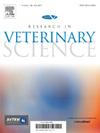Cadaveric study of the ultrasound-guided inter-transversospinalis plane block in dogs for the cervical epaxial musculature region.
IF 2.2
3区 农林科学
Q1 VETERINARY SCIENCES
引用次数: 0
Abstract
Blockage of the dorsal rami of the spinal nerves (DRSN) provides analgesia to the epaxial musculature area in dogs. However, techniques to block the DRSN at the cervical level in dogs haven't yet been investigated. This study aimed to study the anatomy of the cervical area, and to describe a new ultrasound (US)-guided inter-transversospinalis plane (ITP) block technique at the 5th cervical vertebrae (C5). Fourteen adult canine's cadavers were used in this blinded, cadaveric, experimental study. One cadaver for cryo-section, one for anatomical research and twelve to do an ITP injection using 0.3 mL/kg (HV) or 0.15 mL/kg (LV) of dye/contrast solution in each lateral at C5, followed by a computed tomography and anatomical dissection.
The HV and LV groups stained a median (range) of 4.67 (3-6) and 3.67 (2-5) DRSN into the ITP, respectively (P<0.017). Stained DRSN in the splenius plane were found in nine (75%) HV and five (41.66%) LV injections, respectively. Spread in the epidural space was found in two dogs using LV. One of them was injected into the ITP (4.33 %) while the other one was done accidentally outside of this plane. The paravertebral spread was found in one injection of each group. There was no dye of the ventral rami of the spinal nerves. The US-guided ITP injection is feasible in dog cadavers. The LV injected just after the medial surface of the semispinalis capitis muscle is recommended to avoid a possible extensive epidural spread.
超声引导下犬颈椎棘突间平面阻滞的尸体研究。
阻断脊髓背侧神经(DRSN)可为狗的上肢体肌肉区域提供镇痛效果。然而,在狗的颈椎水平阻断 DRSN 的技术尚未得到研究。本研究旨在研究颈椎区域的解剖结构,并描述一种新的超声波(US)引导下的第 5 颈椎(C5)横椎间平面(ITP)阻滞技术。这项盲法尸体实验研究使用了 14 具成年犬尸体。一具尸体用于冷冻切片,一具尸体用于解剖研究,12 具尸体用于在 C5 椎体两侧各注射 0.3 mL/kg(HV)或 0.15 mL/kg(LV)的染色剂/对比剂溶液,然后进行计算机断层扫描和解剖。HV 组和 LV 组在 ITP 中染色的 DRSN 中位数(范围)分别为 4.67(3-6)和 3.67(2-5)(P
本文章由计算机程序翻译,如有差异,请以英文原文为准。
求助全文
约1分钟内获得全文
求助全文
来源期刊

Research in veterinary science
农林科学-兽医学
CiteScore
4.40
自引率
4.20%
发文量
312
审稿时长
75 days
期刊介绍:
Research in Veterinary Science is an International multi-disciplinary journal publishing original articles, reviews and short communications of a high scientific and ethical standard in all aspects of veterinary and biomedical research.
The primary aim of the journal is to inform veterinary and biomedical scientists of significant advances in veterinary and related research through prompt publication and dissemination. Secondly, the journal aims to provide a general multi-disciplinary forum for discussion and debate of news and issues concerning veterinary science. Thirdly, to promote the dissemination of knowledge to a broader range of professions, globally.
High quality papers on all species of animals are considered, particularly those considered to be of high scientific importance and originality, and with interdisciplinary interest. The journal encourages papers providing results that have clear implications for understanding disease pathogenesis and for the development of control measures or treatments, as well as those dealing with a comparative biomedical approach, which represents a substantial improvement to animal and human health.
Studies without a robust scientific hypothesis or that are preliminary, or of weak originality, as well as negative results, are not appropriate for the journal. Furthermore, observational approaches, case studies or field reports lacking an advancement in general knowledge do not fall within the scope of the journal.
 求助内容:
求助内容: 应助结果提醒方式:
应助结果提醒方式:


